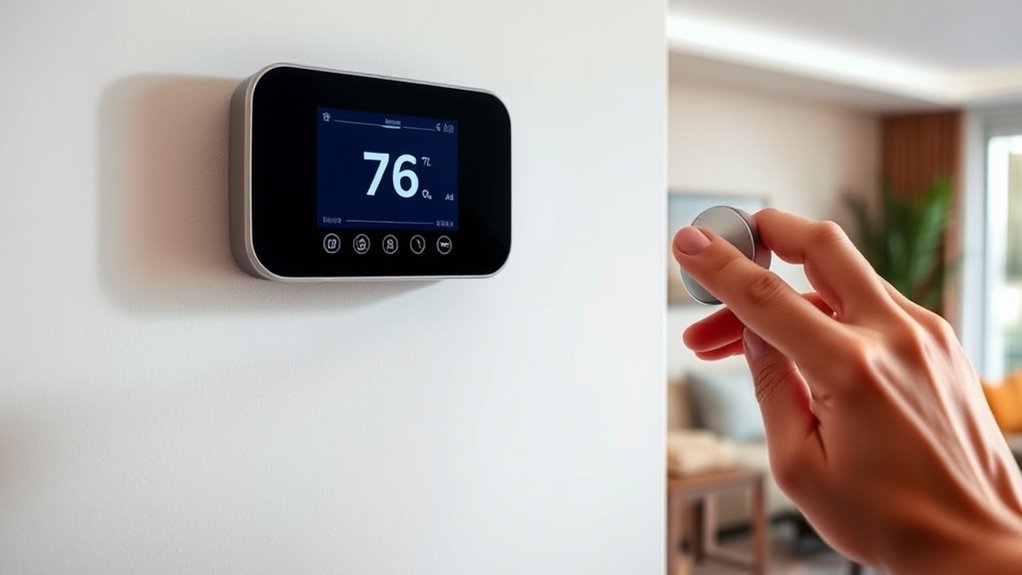To effectively monitor and adjust your thermostat systems, regularly check the sensor readings against a reliable thermometer to guarantee accuracy. Calibrate sensors when you notice temperature inconsistencies or sudden changes, as this improves comfort, saves energy, and extends equipment lifespan. Keep an eye on energy consumption data to optimize settings, like lowering temperatures during absences. Continuing your efforts will help you master fine-tuning your system for peak performance and efficiency.
Key Takeaways
- Regularly check and compare thermostat sensor readings with a reliable thermometer to ensure accuracy.
- Calibrate sensors periodically to prevent drift and maintain consistent temperature control.
- Monitor system behavior for signs of calibration issues, such as frequent cycling or temperature swings.
- Use energy consumption data to identify inefficiencies and optimize thermostat settings accordingly.
- Maintain and adjust your thermostat based on data insights to improve comfort and reduce energy costs.

Have you ever wondered how to guarantee your thermostat system operates efficiently and reliably? The key lies in proper monitoring and regular adjustments, especially when it comes to sensor calibration and managing energy consumption. Your thermostat’s sensors are the brains behind maintaining a comfortable environment, but over time, they can drift out of calibration. When this happens, your system might misinterpret room temperature, causing unnecessary heating or cooling, which wastes energy and increases costs. Regularly checking and calibrating your sensors ensures they accurately measure temperature, allowing your thermostat to make correct decisions. Proper sensor calibration isn’t complicated; it involves comparing the sensor’s readings with a reliable thermometer and making necessary adjustments. Doing this periodically helps keep energy consumption in check because your system only activates when needed, rather than running excessively due to inaccurate readings.
Additionally, understanding thermostat terminology can help you better interpret the data your system provides and facilitate more effective adjustments. By maintaining well-calibrated sensors, you not only improve comfort but also optimize energy use. When your thermostat responds correctly to actual room conditions, it prevents overworking your HVAC system. This efficiency reduces your energy bills and minimizes environmental impact. It’s important to be proactive in monitoring sensor performance—any inconsistencies or sudden changes in temperature readings should prompt recalibration or sensor replacement. Keep an eye on your system’s behavior and the data it provides; if you notice frequent cycling or temperature swings, it might indicate a calibration issue. Addressing these issues early ensures your thermostat operates at peak performance, saving you money and extending the lifespan of your equipment.
Monitoring doesn’t stop at calibration. You should also track your energy consumption regularly. Many modern thermostats come with energy usage reports, giving you insights into how your habits impact your utility bills. Use this data to identify patterns—perhaps certain times of day or specific settings are causing unnecessary energy drain. Adjusting your thermostat’s schedule or settings based on these insights can lead to significant savings. For example, lowering the temperature slightly when you’re away or asleep can drastically cut energy use without sacrificing comfort. Additionally, consider integrating smart features that enable remote monitoring and adjustments, giving you more control over your energy consumption and ensuring your system responds accurately to changes in your environment.
Frequently Asked Questions
How Often Should I Calibrate My Thermostat?
You should calibrate your thermostat at least once a year to guarantee maximum accuracy. Regular calibration helps maintain thermostat accuracy, preventing temperature discrepancies that could increase your energy bills or cause discomfort. If you notice your system isn’t responding correctly or the temperature feels off, recalibrate sooner. Keep an eye on your thermostat’s performance and schedule calibration accordingly, so your heating and cooling stay consistent and efficient throughout the year.
What Signs Indicate My Thermostat Needs Replacement?
If your thermostat’s acting up, you’re not alone; about 30% of systems fail prematurely. Signs you need a replacement include noticeable temperature fluctuations, inconsistent heating or cooling, and frequent system malfunctions. If your thermostat struggles to maintain set temperatures or responds slowly, it’s time to think about a new unit. Upgrading ensures accurate control, energy savings, and comfort, preventing costly repairs down the line.
Can I Upgrade to a Smart Thermostat Easily?
Yes, upgrading to a smart thermostat is usually easy. You’ll enjoy smart features like remote control, energy savings, and scheduling. The installation process is straightforward; most models fit into your existing wall space and connect wirelessly to your Wi-Fi. Just follow the manufacturer’s instructions, or consider professional installation if you’re unsure. It’s a simple upgrade that can make your home more comfortable and energy-efficient.
How Do External Weather Changes Affect Thermostat Performance?
Think of your thermostat as a ship’s captain steering through changing weather. Weather fluctuations and seasonal adjustments challenge its performance, causing it to struggle in maintaining consistent comfort. When temperatures drop or rise unexpectedly, your system works harder, risking inefficiency. Regularly update your thermostat settings to adapt to these external changes, ensuring smooth sailing through seasonal shifts and keeping your home cozy, no matter the weather outside.
What Safety Precautions Should I Take When Adjusting Thermostats?
When adjusting thermostats, prioritize fire safety and electrical safety. Turn off the power before making any adjustments to avoid electrical shocks. Use insulated tools and avoid working near water. Keep fire safety in mind by ensuring the thermostat is properly installed and vents are clear. If you’re unsure, consult a professional. Always follow manufacturer instructions and never force parts or wires, protecting yourself and your home.
Conclusion
By keeping a close eye on your thermostat system, you’re the captain steering a ship through calm and stormy seas alike. Regular monitoring and adjustments act like a lighthouse, guiding your home to perfect comfort and efficiency. When you stay attentive, your system responds like a loyal crew, working seamlessly to maintain the ideal temperature. With each mindful tweak, you’re weaving a cozy, well-orchestrated symphony that makes your living space feel like a warm, welcoming haven.









